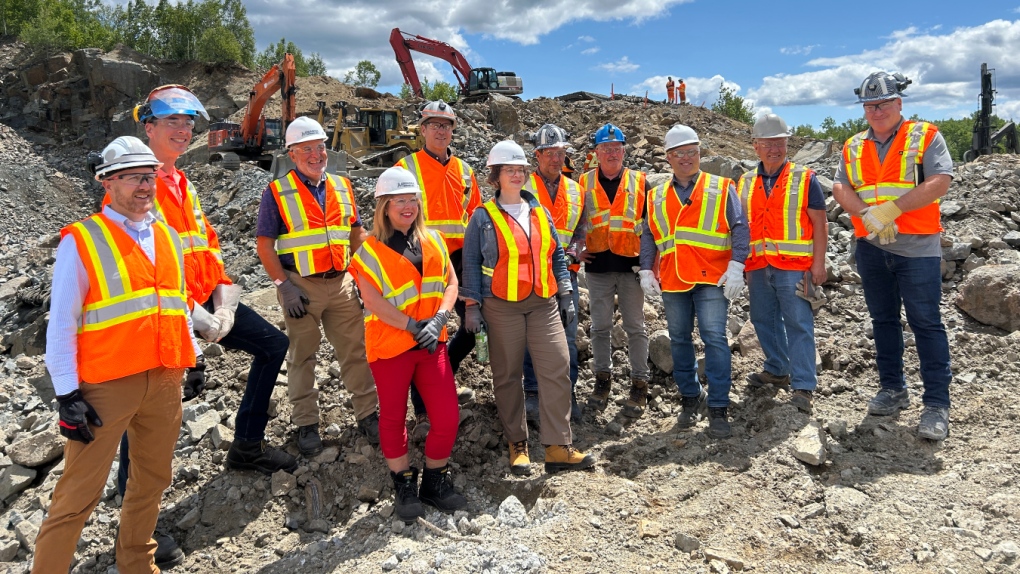Sudbury's Crean Hill Mine begins operations
What was old is new again at Greater Sudbury's Crean Hill Mine.
Magna Mining, which purchased the site in 2022 in partnership with Vale, hosted a tour of the re-opened site Thursday.
Sudbury MP Viviane Lapointe and Nickel Belt MP Marc Serré attended the tour.
- Download our app to get local alerts on your device
- Get the latest local updates right to your inbox
"It's really important when we look at the critical minerals strategy and we're looking at a lot of the mining in northern Ontario," Serré said.
"Also moving forward, here's a lot of good paying jobs in the area once again, that we're trying to build that mining brand in northern Ontario."
Previously owned by numerous companies, including the former Inco, the nickel and copper-producing mine operated from 1900 to 2002, but closed due to low nickel prices.
Jason Jessup, CEO of Magna Mining, said a lot has changed since the mine's closure.
"Since then, there's been a rebound in metal prices. There's been over 90,000 meters of drilling completed on the project," Jessup said.
"So we're fortunate to acquire the project, come out with a large resource and we believe it has potential to sustain a long mine life."
 Sudbury MP Viviane Lapointe and Nickel Belt MP Marc Serré attended Thursday's tour of Crean Hill Mine. (Amanda Hicks/CTV News)
Sudbury MP Viviane Lapointe and Nickel Belt MP Marc Serré attended Thursday's tour of Crean Hill Mine. (Amanda Hicks/CTV News)
He added that there's a lot of untapped potential at the site.
"As society transitions into more green energy, there's going to be huge demand for nickel and copper," he said.
"Sudbury is one of those regions that can supply a lot of these metals, especially in North America. So we're really, really fortunate to have great timing to be bringing all this project together and to be looking forward to starting up a new mine here in Sudbury."
Using new technology, the mine will produce gold, platinum, copper, nickel and cobalt.
Magna site's contractor is ADLP, a joint venture between Atikameksheng Anishnawbek, Wahnapitae First Nation and Technica Mining.
Jessup said while blasting began last week, the company has been busy over the last 18 months.
"We needed the engineering studies, a tremendous amount of exploration and we believe (we) will be coming out with a new resource that will grow those resources that we currently have even larger, which has potential to further extend the mine life," he said.
"So it's been really busy and we're only getting started."
The lifespan of the project is estimated at 15 years.
Currently, the work is in Phase 1, an eight-week project above ground. Sometime in the fall, the project will move into Phase 2, which will take place underground.
CTVNews.ca Top Stories

New rules clarify when travellers are compensated for flight disruptions
The federal government is proposing new rules surrounding airlines' obligations to travellers whose flights are disrupted, even when delays or cancellations are caused by an "exceptional circumstance" outside of carriers' control.
Music maker, 88, creates unique horn section, with moose antler bass guitar and cello
Eighty-eight-year-old Lorne Collie has been making musical instruments for more than three decades, creations that dazzle for their unique materials as much as their sound.
opinion Tom Mulcair: Prime Minister Justin Trudeau's train wreck of a final act
In his latest column for CTVNews.ca, former NDP leader and political analyst Tom Mulcair puts a spotlight on the 'spectacular failure' of Prime Minister Justin Trudeau's final act on the political stage.
'Being pushed to the brink': Alberta Children's Hospital adds beds amid waves of respiratory virus patients
An influx of children sick with respiratory viruses is putting pressure on the Alberta Children's Hospital, which has brought in extra beds to meet the increased demand.
Germans mourn the 5 killed and 200 injured in the apparent attack on a Christmas market
Germans on Saturday mourned the victims of an apparent attack in which authorities say a doctor drove into a busy outdoor Christmas market, killing five people, injuring 200 others and shaking the public’s sense of security at what would otherwise be a time of joy and wonder.
London Ont. Liberal MPs say that Trudeau is taking time to reflect on his future
Both of London’s Liberal MPs are choosing their words carefully when it comes to their party's leadership future. They were asked about the situation in Ottawa at Friday's housing announcement in London.
Blake Lively accuses 'It Ends With Us' director Justin Baldoni of harassment and smear campaign
Blake Lively has accused her 'It Ends With Us' director and co-star Justin Baldoni of sexual harassment on the set of the movie and a subsequent effort to “destroy' her reputation in a legal complaint.
Trudeau's 2024: Did the PM become less popular this year?
Justin Trudeau’s numbers have been relatively steady this calendar year, but they've also been at their worst, according to tracking data from CTV News pollster Nik Nanos.
Wild boar hybrid identified near Fort Macleod, Alta.
Acting on information, an investigation by the Municipal District of Willow Creek's Agricultural Services Board (ASB) found a small population of wild boar hybrids being farmed near Fort Macleod.

































